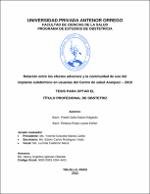Relación entre los efectos adversos y la continuidad de uso del implante subdérmico en usuarias del Centro de salud Aranjuez – 2019

View/Open
Download
(application/pdf: 529.8Kb)
(application/pdf: 529.8Kb)
Date
2022Author(s)
Pretell Zaña, Edson Edgardo
Rebaza Rojas, Loyda Esther
Metadata
Show full item recordAbstract
El presente estudio tuvo como objetivo determinar la relación entre los efectos adversos y la continuidad de uso del implante subdérmico en usuarias del Centro de Salud Aranjuez – 2019. Se trató de una investigación ex-post-facto, de enfoque cuantitativo, de nivel descriptivo de relación y de diseño no experimental retrospectiva; además, se utilizó una ficha de recolección de datos para analizar 90 historias clínicas de pacientes con implante subdérmico del Centro de Salud Aranjuez. Los hallazgos evidenciaron que el 85.6% presentó acné después de haber usado el implante subdérmico, el 82.2% alteración emocional, 68.9% tensión mamaria, 62.2% dismenorrea, 60% amenorrea, 56.7% tuvo alteración de peso, 51.1% dolor en el sitio de inserción, 32.2% presentó cefalea y 18.9% sangrado; además, el 64.4% de las usuarias continuaron usando el implante subdérmico, sin embargo, el 35.6% restante optó por su extracción. También, el 61.1% de usuarias fueron adultas jóvenes de 24 a 35 años, 32.2% menores de 24 años y 6.7% mayores a 35 años; respecto al tiempo de uso del implante, el 37.8% lo usó por 6 a 9 meses, 33.3% por más de 9 meses y 28.9% por menos de 6 meses. En conclusión, se halló relación significativa entre la continuidad de uso del implante subdérmico y todos los efectos adversos evaluados, aceptándose la hipótesis alterna de investigación (p<0.05). The objective of this study was to determine the relationship between the adverse effects and the continuity of use of the subdermal implant in users of the Aranjuez Health Center - 2019. It was an ex-post-facto investigation, with a quantitative approach, with a descriptive level of relationship and retrospective non-experimental design; In addition, a data collection form was used to analyze 90 medical records of patients with subdermal implants from the Aranjuez Health Center. The findings showed that 85.6% had acne after using the subdermal implant, 82.2% emotional disturbance, 68.9% breast tension, 62.2% dysmenorrhea, 60% amenorrhea, 56.7% had weight disturbance, 51.1% pain at the site of insertion, 32.2% presented headache and 18.9% bleeding; In addition, 64.4% of the users continued using the subdermal implant, however, the remaining 35.6% opted for its removal. Also, 61.1% of users were young adults between 24 and 35 years old, 32.2% under 24 years old and 6.7% over 35 years old; Regarding the time of use of the implant, 37.8% used it for 6 to 9 months, 33.3% for more than 9 months and 28.9% for less than 6 months. In conclusion, a significant relationship was found between the continued use of the subdermal implant and all the adverse effects evaluated, accepting the alternative research hypothesis (p<0.05).
Collections
- Obstetricia [145]

